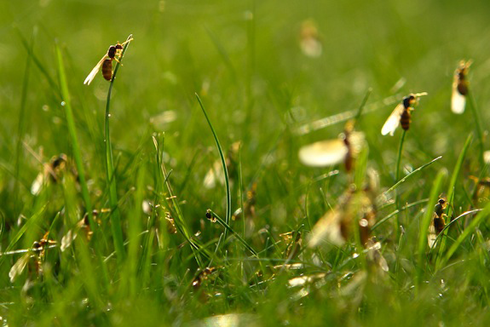Survey debunks myth of 'flying ant day'

Warm weather this year and last has caused multiple flights of flying ants, often thought only to swarm once a year.
The annual swarming usually occurs from early to mid July each year, coinciding with hot and humid weather, usually only lasting a few days.
However, a survey launched by the Society of Biology in 2012, with data analysed by Professor Adam Hart at the University of Gloucestershire, has shown more complex swarming patterns over the past two years.
Similar patterns are expected this year. The 2014 survey was launched on 13 June and invites the public to send in flying ant sightings so scientists can plot the swarms taking place this summer.
More flying days
'The good weather seems to be causing multiple flights with much less synchrony than we saw in 2012,' Prof Hart said. 'So far the idea of a flying ant day is very much a myth. Last year we had a flying ant month.'
The survey results from 2012 showed two flying ant days divided by two weeks of poor weather, with an even more complex pattern in 2013 with four peaks of flying ant appearance between 22nd July - 22nd August.
Flying ants are the sexually mature queens and males of the common black ant, Lasius niger, known as alates. Worker ants will have been preparing to swarm during the past few weeks, with heaps of soil appearing above their nests.
The alates emerge from the nest every year and take flight, looking for a mate. The large winged females and the smaller winged males are often seen flying joined together, which is known as the nuptial flight.
Strength in numbers
Swarming in large numbers all at once provides protection for the ants from predators. The larger the swarm, the more predators are kept away.
Another reason for their large numbers is to increase the chance of reproduction.
Brief encounter
Once they've mated, the role of the males is over. The mated queens quickly shed their wings and begin looking for a suitable site to nest and create a new colony of their own.
These flying insects may seem annoying to some people, but their tunnelling activities are important to improving soil quality.
The swarming events also provide a vital food resource for many species of birds. Swifts and gulls can often be seen feeding frenziedly from rising swarms of ants.
There are about 60 species of ant in the UK, which all live in complex colonies. Other non-native species are becoming more widespread, including the pharaoh and Argentine ants.
Nationwide event
'We need as many records as we can get so that we can tease out all the factors that might be affecting one of the most interesting nationwide wildlife events we have here in the UK,' Prof Hart said.
Museum identification service
Seen a strange bug in your home or garden? Ask a Museum scientist to identify it by using our Identification and Advisory Service, or by posting a photo on our bug forum.
Provided by Natural History Museum



















